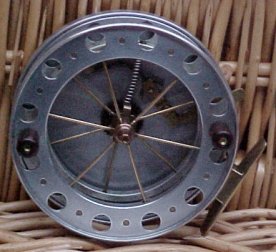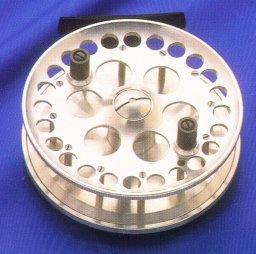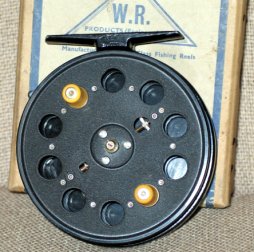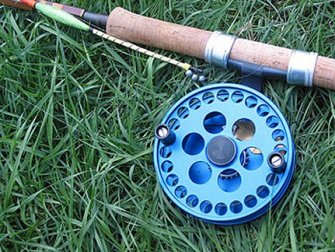Centrepins and Bearings
The question I am most commonly asked when people talk to me about centrepins is "how do I Wallis cast?"
Most questions on centrepins seem to link to one another anyway & this is no exception. What does have a bearing (excuse the pun) on how well you will be able to cast is which reel you choose. The question about reel choice is asked almost as frequently & usually ends up in a discussion about the relative merits of different types of reels. Assuming, as I must for this piece, that we are talking about reels of similar build quality the major divide here is between reels that have a plain bearing - true-pins if you like - & reels that have more than one bearing, i.e. that run on ball races.
I'll explain further. The plain bearing pin has one point of contact between the spool & the spindle. This is where the outer most point of the curve on the small (grub) screw located in the centre of the spool touches the top of the curve at the top of the spindle (if your reel doesn't have a curve there it's worn out!). At times during the cast there will be almost certainly be minimal contact between the spindle, & the shaft on which it sits, though this will be buffered by oil on the spindle. The relevance of this "contact" will become apparent.

A superlative plain-bearing reel.
The ball-race reel has a ball-race at each end of the spindle & the spool revolves within these. Each ball-race may contain up to a dozen bearings. Bearings come in various grades & I doubt any reels are made with the very best ones as this would be prohibitively expensive. I keep wanting to say "this has a bearing on such & such…". I'll think of another way to write it! These two different methods of making a reel spin do have an effect on both fishing and casting. I'll come back to that in more detail later.

One of the very best of the ball-race reels.
I have quite a bit of experience with both types of reel & will say right away that I would choose the "true-pin" every time. Now I suppose I shall have to explain why. Well first of all I'll be totally non-technical & say that when Wallis casting, plain bearing reels have a better feel about them than ball-race reels . Why is this? Although I am told that from an engineering standpoint there should be little inertia in a ball-race reel, that type of bearing in theory giving very little resistance, they are undoubtedly slow off the mark compared to plain bearing reels. It might be something to do with weight, as all the ball-race reels I've used have had heavier spools than their plain bearing counterparts. Lightness of spool is essential in a good Wallis casting reel. Some of the more recent ball-race reels are (apparently) made using "low-inertia" bearings. I'm not exactly sure what they are (?) but as, in theory, ball-races are supposed to be low inertia anyway, I have to wonder if that's relevant or indeed accurate.

Superb reels if in good condition.
How does the method of construction affect casting? I've already dealt with inertia, though admit to not entirely understanding it. An engineering friend of mine tells me there is far less inertia in ball-races than plain bearings. He argues that the contact between shaft & spindle on a true pin will give more resistance than a ball-race. I don't have an engineering background & can only argue that point from logic & experience. A common misunderstanding is that in order to Wallis cast you need a reel that will spin for "5 minutes". I often see people pick up centrepins and give them a real hard bat. That's not the ideal way to test a reel. Just give it a slight tap & see how freely it spins, & whether, after stopping, it then moves back slightly in the other direction. That is a free-running reel.
Now to casting & fishing. Many anglers will know that when trotting, the centrepin will run better if the rod is held in such a way that the reel is flat, i.e. with the handles pointing skywards. I wonder how many of them realise that this is not the case with ball-race reels? If you have reels of both types try this - in turn hold each reel flat in your hand & spin it. Then turn it sideways. Because of the single point of contact on the bearing on a true pin, moving the reel in this way will create resistance as there is minimal contact between shaft & spindle, & the reel will slow down. The ball-race reel will not, not until it runs out of energy anyway. On the face of it this might seem like a good thing. It's not. It's a common misconception that ball-race reels don't cast so well because they are less free running than plain-bearing reels. Leaving the mysterious inertia out of the equation, the problem with ball-race reels is that they are too free-running! How can that be? When you Wallis cast you need the reel to start moving very quickly to keep pace with the end-tackle, which is moving at its fastest at this time. As the tackle travels further through the air so it begins to slow down. A true-pin will also slow down, & this is very handy as it helps the reel keep pace with the tackle without any intervention from you (but don't forget to stop the reel when the tackle hits the water!). You can also help this slowing process by starting the cast with the reel flat, then turning it during the cast, as we did in the test above. In some cases anglers will do this without realising it.
The ball-race reel won't slow down unless you slow it down yourself. It is extremely difficult to consistently slow down a ball-race reel at exactly the same rate as the end tackle is slowing (& knurled rims certainly don't help with the fine control needed here). In practice the result of attempting a long cast with a ball-race reel can be either that you stop the reel to soon, or that you don't stop it soon enough. The first instance will just see the end tackle drop short. The second may give you a nasty birds-nest. I find casts much beyond 15 yards difficult to control consistently with a ball-race reel, though that won't matter to you if you only wish to fish at that range.

Another excellent ball-race reel.
In trotting the stream with float tackle a similar principle applies. Rarely will the float travel at the same speed all the way down the swim. The plain-bearing reel will help a little in keeping the line tight as the float slows. The ball-race reel may need more control applied by the angler. That is theory - in practice it perhaps makes little difference though sometimes it will. What you can do with the true pin is to hold back a fraction more merely by moving the reel position as described above - it's a ploy I use frequently.
Scientific? Not really. The above comes from many years of using centrepin reels. I wouldn't be so arrogant as to say I'm totally right - I'm learning all the time. But this is how things appear to me at the moment. I hope it helps answer some of your questions.